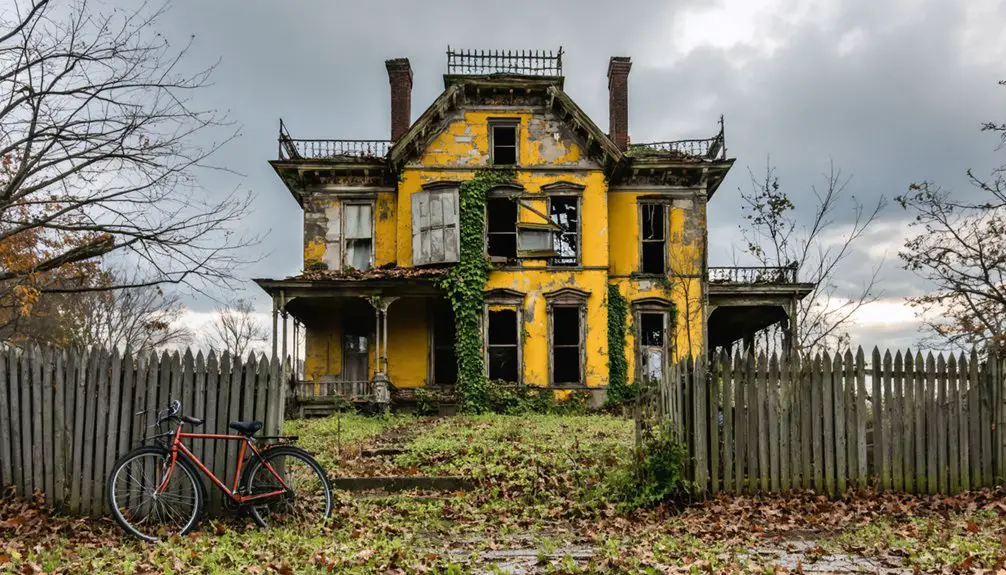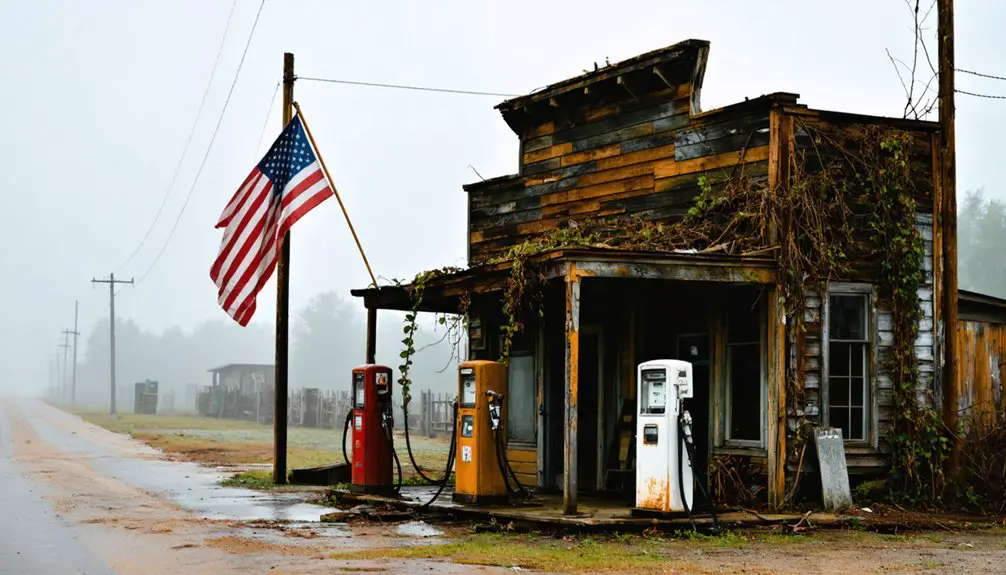You’ll find Dicktown, an abandoned settlement in Putnam County, New York, near Sagamore Lake at an elevation of 682 feet. This former community, named for its high number of Richards among early settlers, thrived on timber harvesting and farming before declining in the early 20th century. Now part of the area near Clarence Fahnestock State Park, its remaining structures and roads tell a fascinating tale of rural New York’s changing landscape and demographics.
Key Takeaways
- Dicktown is an abandoned settlement in Putnam County, New York, near Sagamore Lake at coordinates 41.4758°N, -73.7750°W.
- The town’s name originated from an unusually high number of early settlers named Richard who established the community.
- The settlement declined in the early 20th century due to economic challenges and the expansion of Clarence Fahnestock State Park.
- Former residents primarily engaged in timber harvesting, subsistence farming, and local trade before abandoning the area.
- Located at 682 feet elevation, the ghost town’s remaining structures are now surrounded by mixed hardwood forests and protected wetlands.
The Origins Behind Dicktown’s Unique Name
While many towns derive their names from geographical features or prominent founders, Dicktown, New York earned its distinctive moniker from an unusual demographic quirk – an unusually high number of early settlers named Richard.
This name significance reflects a common practice in early American settlements, where communities often adopted names tied to their cultural identity and settler demographics. To avoid confusion with other similarly named locations, the town’s entry requires disambiguation guidance for researchers.
You’ll find that unlike other towns named after surnames or landmarks, Dicktown’s name emerged from the prevalence of a first name among its residents.
Like many of the state’s 11 recognized ghost towns, Dicktown stands as a testament to New York’s evolving settlement patterns.
The informal nature of this naming convention stands out in New York’s diverse toponymic landscape, making it a unique example of how settler populations influenced local place names.
Among New York’s place names, Dicktown’s casual origin reveals how early settler communities could shape local geography through informal naming.
Historical records consistently support this origin story, with no competing theories about indigenous or geographic influences.
Historical Settlement and Development
Nestled near Sagamore Lake in Putnam County, Dicktown emerged as a modest settlement in New York’s rugged Hudson Valley region. Early settlers, drawn to the area’s abundant natural resources, established a close-knit community that relied on timber harvesting, subsistence farming, and local trade. Similar to early settlements like Blue Anchor Inn in Winslow Township, the community served as a central meeting point for local governance and trade. The name represents a small, insignificant place reflecting its limited size and scope.
The settlement’s early community practices centered around:
- Utilizing the dense forests for lumber and charcoal production
- Developing small-scale agricultural operations on available arable land
- Establishing local services like blacksmith shops and general stores
- Creating informal gathering spaces for social and economic activities
You’ll find that Dicktown’s development remained constrained by its limited transportation infrastructure and challenging terrain.
While the settlement’s isolation preserved its rural character, it also restricted growth beyond basic local needs, leading to a self-sufficient but modestly sized frontier community.
Transformation Into a Ghost Town
The vibrant frontier spirit that once characterized Dicktown began to wane in the early 20th century, marking the settlement’s gradual descent into abandonment.
You’ll find that multiple abandonment causes converged – the economic decline stripped away local businesses and job opportunities, while nearby Clarence Fahnestock State Park’s expansion limited development potential.
Like Doodletown’s ski slopes, abandoned development projects in the region contributed to the area’s decline. As residents sought better prospects in urban areas, the community’s infrastructure crumbled. The remaining buildings succumbed to nature’s reclamation, with forest vegetation overtaking the ruins. The location now evokes an eerie sad nostalgia typical of ghost towns worldwide.
Without sustainable industries or commercial activity to anchor the population, Dicktown’s social fabric unraveled. Schools and shops closed their doors, and neighbors departed one by one until the settlement joined other Hudson Valley ghost towns, leaving only foundations and forgotten pathways as evidence of its existence.
Geographic Location and Natural Surroundings
Located at 41.4758°N latitude and -73.7750°W longitude in Putnam County, New York, Dicktown sits at an elevation of 682 feet amid the Hudson Valley‘s characteristic rocky uplands. Similar to Smithtown, NY which lies further east on Long Island, the area features distinctive geographic coordinates that help pinpoint its exact location.
You’ll find this ghost town within the USGS Oscawana Lake topographic map area, where the upland geography shapes a diverse landscape of forests and wetlands. The area is well documented through detailed GeoPDF maps available for research and navigation purposes.
The natural surroundings feature:
- Mixed hardwood forests supporting rich wildlife habitats
- Aquatic ecosystems centered around nearby Oscawana Lake
- Rocky terrain that influences local drainage patterns
- Protected wetlands that filter water and control flooding
The site’s position in Putnam County places it about an hour’s drive north of Manhattan, yet its rugged terrain and numerous water bodies have helped preserve its untamed character, limiting extensive development throughout its history.
Legacy in New York’s Rural History
Standing as a symbol to New York’s evolving rural landscape, Dicktown’s legacy reflects the broader pattern of small settlement abandonment in the Hudson Valley region.
You’ll find its story differs from many New York ghost towns, as it wasn’t tied to mining booms or sudden industrial collapse. Instead, Dicktown’s fate emerged from demographic shifts that saw rural populations steadily moving toward urban centers.
Unlike its better-documented counterparts, this hamlet’s significance lies in its representation of countless small settlements that once dotted New York’s countryside.
The remaining roads and buildings stand as silent witnesses to the community that once thrived here.
Though physical remnants are scarce, Dicktown lives on in cultural memory as one of at least six ghost towns in the Hudson Valley.
Like the abandoned Frontier Town Park, it serves as a testament to changing times and shifting interests in the region.
It’s a powerful reminder of how changing agricultural practices and population movements have reshaped the state’s rural identity.
Frequently Asked Questions
Are There Any Remaining Structures or Buildings Still Standing in Dicktown Today?
Like finding a smartphone in 1850, you won’t spot any standing abandoned structures in this location today. Historical preservation records don’t indicate remaining buildings, though the area’s still accessible off Route 301.
When Was the Last Recorded Permanent Resident Living in Dicktown?
You won’t find official records of the last resident in historical documents, though regional ghost town patterns suggest permanent habitation likely ended mid-20th century, with no confirmed ghost sightings since then.
What Local Legends or Supernatural Stories Are Associated With Dicktown?
You’ll find few ghostly encounters here, but legends tell of visitors experiencing identity confusion due to the town’s Richard-centric history. The haunted history focuses on psychological disorientation rather than traditional spirits.
Can Visitors Legally Explore the Former Town Site of Dicktown?
While you might be enthusiastic to explore, you can’t legally enter without proper permission. Your best option is staying on public trails in Fahnestock State Park, respecting exploration regulations and visitor safety guidelines.
Were There Any Notable Businesses, Churches, or Schools Operating in Dicktown?
You won’t find records of major historic establishments or community events in this settlement – while mills operated early on, there’s no documented evidence of notable businesses, churches, or schools.
References
- https://hudsonvalleypost.com/new-york-state-is-home-to-nearly-20-ghost-towns/
- https://en.wikipedia.org/wiki/Dicktown
- https://lite987.com/11-ghost-towns-new-york-state/
- https://hudsonvalleycountry.com/6-mysterious-hudson-valley-ghost-towns/
- https://943litefm.com/tags/ghost-town/
- https://hudsonvalleycountry.com/doodletown-a-look-inside-the-hudson-valleys-most-popular-ghost-town/
- https://en.wikipedia.org/wiki/Wikipedia:Unusual_place_names
- https://www.insidernj.com/map-poi/township-of-winslow/
- https://theworld.org/stories/2016/03/22/wait-youre-where-10-towns-and-cities-suggestive-names
- https://thenew961.com/results-are-in-for-the-top-10-snobbiest-states-congratulations-new-york/



